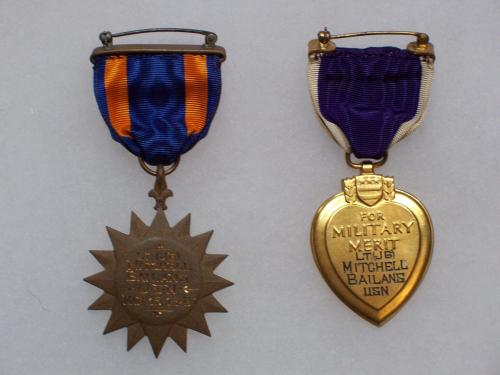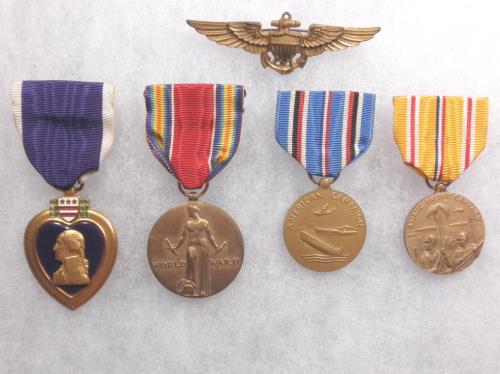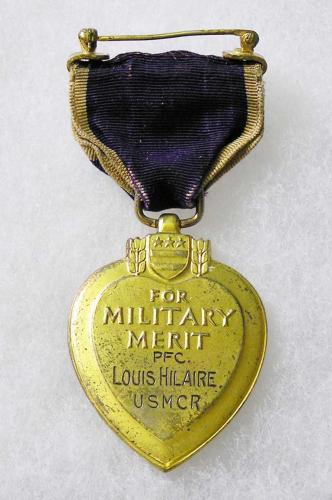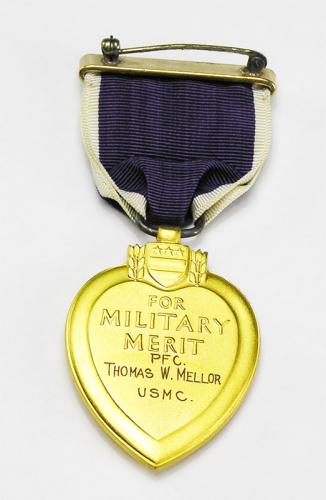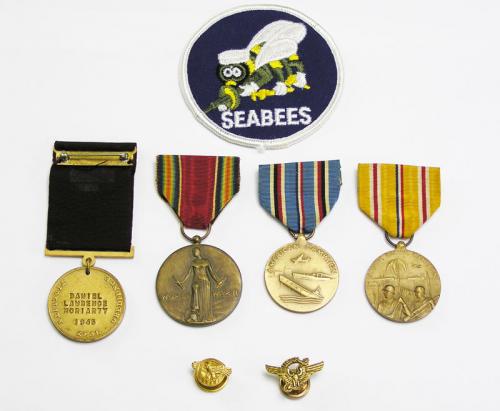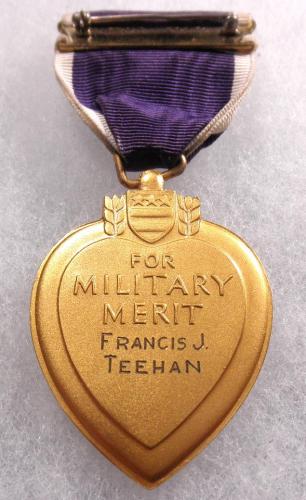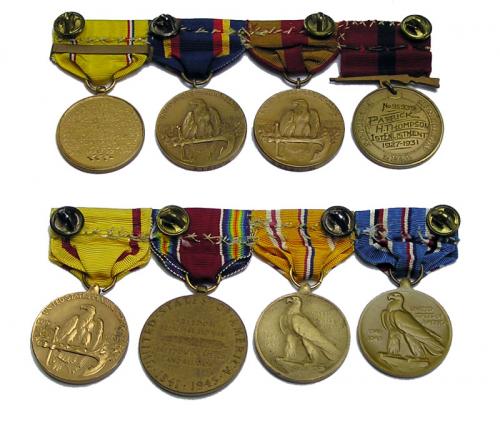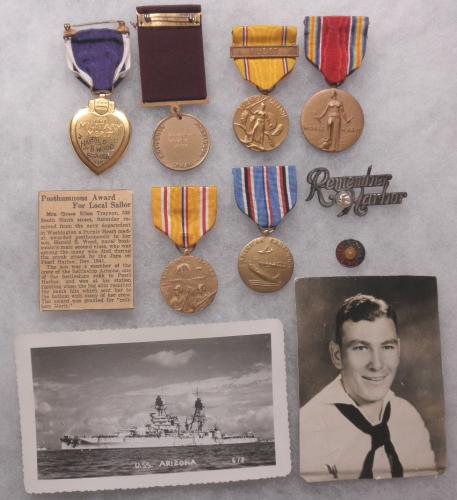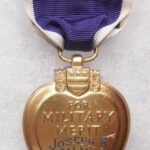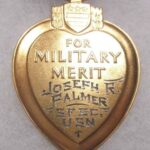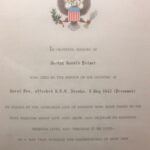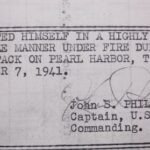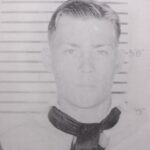Joseph Ronald Palmer was born June 14, 1921 in Dunlap, Iowa. He enlisted in the Navy September 15, 1939 in Seattle, Washington, and was appointed Apprentice Seaman. His grandmother, Grace Foote of Aurora, Illinois, was his legal guardian at the time and signed a consent form for him to enlist because he was under age. He received training at the US Naval Training Station in San Diego. He reported to USS Rigel, AD-13, November 17, 1939 as Able Seaman. Notations in his record indiacate that he had received instructions for the BAR, Lewis Gun and 30 cal. M2. He made S2c January 15, 1940. He then reported to USS Kingfisher AM-25, June 21, 1940 as S2c. He is shown in hospital in Hawaii starting October 12, to October 29, 1940.
Joseph Palmer was appointed S1c November 16, 1940, and reported to the USS Neosho on January 29, 1941. He was appointed SF3c July 1, 1941. On May 1, 1942, he was advanced in rating to SF2c. He was stationed on the Neosho in Pearl Harbor during the Japanese attack. His service record has the following entry for Dec. 7: "CONDUCTED HIMSELF IN A HIGHLY COMMENDABLE MANNER UNDER FIRE DURING THE ATTACK ON PEARL HARBOR, T.H. ON DECEMEBER 7, 1941. (s) John S. Phillips, Captain, US Navy, Commanding. The last entry in his service record shows him Missing in Action May 7, 1942. USS Neosho was sunk on May 7, 1942. Most of this information was obtained from his official service record from St. Louis that accompanies this group.
SF2c Joseph Palmer's group includes his sterling silver Type 1 split brooch posthumous Purple Heart with its small purple presentation box as issued by the US Mint; and the Roosevelt Accolade in its mailing tube that was sent to his father Jake Palmer in Alhambra, California.
The following is from www.delsjourney.com:
At 7:55 a.m., December 7, 1941, in Pearl Harbor, the Neosho had almost finished unloading its tanks when, all hell broke loose. Waves of Japanese planes suddenly attacked and mercilessly pummeled the U.S. Pacific Fleet, sitting idly at anchor. During a slight lull in the battle, the Neosho, one of the first ships at Pearl Harbor that morning to get under way, headed for safety on the Oahu mainland and dodged bombs and torpedoes while shooting down at least one Japanese plane. The Neosho was the only ship berthed on "Battleship Row" that terrible morning which was not damaged.
The Neosho played an important role in the Battle of the Coral Sea, first fueling the American fleet and then acting as an unwitting decoy. On May 7, 1942, Japanese dive-bombers, searching for the main American fleet, discovered instead the Neosho and its escorting destroyer, the U.S.S. Sims, mistaking the flat-topped Neosho for an American aircraft carrier and the Sims for a cruiser. These ships had been left behind in a supposed safe area while the rest of the American fleet had sailed ahead looking for the Japanese fleet. During a relentless attack by 62 Japanese planes, the U.S.S. Sims valiantly defended the vulnerable Neosho but was sunk with the loss of 237 men. The only survivors of the Sims, 15 men, clambered into a life boat and headed for the Neosho, which itself had been hit by seven bombs and one Japanese plane.
Burning and immobilized, the Neosho began listing sharply in the choppy seas. Afraid that the Neosho would capsize, Captain John Phillips ordered the crew to prepare to abandon ship, but the message got garbled and dozens of men immediately jumped into the water. Many of those drowned while others piled into the three motorized whale boats that slowly circled the ailing ship. Dozens more clambered onto liferafts that slowly drifted away from the Neosho, most of whom were never seen again.
The next morning, the men on the motor whaleboats went back aboard the immobilized Neosho, now listing at 30 degrees with the starboard rail underwater, and Captain John Phillips did a head count. Of the 293 men onboard the ship before the attack, 20 men were confirmed dead and 158 men were missing, many of whom were on the rafts that had drifted away from the ship. 129 other men — 114 from the Neosho and 15 from the Sims — clung to the deck of the listing Neosho and, like the men in the rafts drifting away from the ship, expected to be rescued quickly. However, unknown to everyone, the ship's navigator had plotted the coordinates incorrectly, an error of about 60 miles, coordinates that had been transmitted to the U.S. fleet.
Despite the battering it had suffered, the Neosho refused to sink, buoyed by her partly-emptied tanks. The deck of the listing ship, however, was a mess. Half of the men were burned or wounded and almost everyone was covered with diesel oil. The men, patiently waited in the hot sun for three days without knowing what had happened in the battle, and had almost abandoned the Neosho when they were spotted by a scout plane. The next day, May 11, they were rescued by an American destroyer, the U.S.S. Henley. After the surviving 123 men were safely aboard the Henley, the destroyer tried to sink the Neosho so that the Japanese wouldn't find her. The ailing tanker was stubborn, though, and it took two torpedoes followed by 146 shells to put her under. Finally she began to sink, stern first, and many of the Neosho's crewmen wept from the deck of the Henley as they watched their beloved tanker sink beneath the waves.
Only 111 of the 293 men on the Neosho and 13 of the 252 men onboard the Sims survived the attack. In other words, of the 545 men serving on both ships before the Battle of the Coral Sea, 124 survived while 421 men perished.
SOLD to a collector 04-2021
